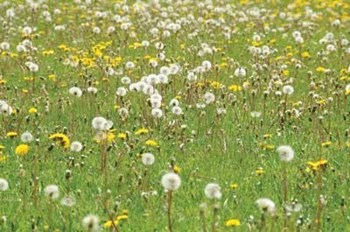
The adage is, “The customer is always right.” But when it comes to lawn care for condominium properties, the first question is, “What does the customer want?” According to Matt Lindner, the service line director for SavaLawn in Bedford Hills, New York, the bottom line is that “the demands of the property owner determine the inputs needed for healthy turf.” Perpetually lush, green, weed-free lawns require a lot of care and regular maintenance. Condominium owners who are willing to budget for and endorse the necessary means for sustaining such lawns will receive their just returns.
Nourishing lush green lawns in New England is not without its challenges, however. “Water,” says Michael Quirk, director of sales and marketing for Greener Horizon in Middleboro, Massachusetts, “is one of the biggest challenges condo properties face in terms of maintaining their turf. Many sites have fully automatic irrigation systems; however, many do not. This is key to having lush, healthy turf.” Quirk also says “another factor that affects lawns in New England is the high level of clay soils. Lawns with clay soils require more frequent core-aeration to help reduce compaction from clay.”
Climates Change
Patrick Lindquist, the lawn care division specialist for Leahy Landscaping in Lynn, Massachusetts, adds that one more “challenging variable is the inconsistent and fluctuating weather patterns. Weather has a huge influence over conditions of turf grass and can be the leading cause of turf grass disease.” Also, condominium properties may have “different micro climates and micro environments. Due to the size of a lot of condo complexes, turf grass can be growing in very different environments from one area to another. When looking to maintain a condo complex, it is difficult to just keep a cover-all program for the entire complex.”
Unfortunately, though, the biggest mistake held in common when it comes to lawn care is misunderstanding the needs of different lawns. “You can’t just drive to your local Lowe’s and pick out a bag of mixed grass seed,” says Lindner of SavaLawn, which has offices in Massachusetts and Connecticut. “The most important service a lawn care company does is a soil test. This is the ‘blood test’ for the needs of the lawn, or, for that matter, the landscape. The results of the test will determine what inputs are required to keep your plants and lawn growing and healthy.” Lindner indicates that matching the right grass to the appropriate conditions is imperative. If an area of the property gets full sun and has adequate irrigation, he might choose a Bluegrass for that part of the landscape; but another parcel on the same property may be very shady and not receive as much irrigation, in which case he’d plant fine Fescues which can “survive on much less water, around 3 to 4 hours of sunlight, and go dormant during times of stress.”
Just A Little Off the Top
Even if appropriate grass seed is planted, however, “choosing proper mowing heights is essential throughout the year,” says Lindquist. “A common mistake that is made is to cut the grass short to reduce the total number of cuts — but cutting the grass too short in times of high heat or humidity can cause tremendous stress on the turf grass plant, leading to greater problems such as disease or weeds.” He indicates that “another mistaken practice that exists and causes damage to turf grass is being on the lawn when there is a frost. When there is a frost it is best to stay off the turf grass completely. The damage that exists will not kill the turf grass plant, but it will bend and break the shoots of grass, causing stress.”
Quirk adds that an issue he has encountered is that “residents turn off and on the irrigation control clock at their will without notifying the landscape contractor. Many times a resident or board member turns off the system during a period of rain, only to forget to turn it back on during a stretch of sunny and 85-degree weather. The best way to remedy this is to lock the control clocks so that tampering is prevented, especially when the landscape contractor is responsible for the maintenance of the system.” If that isn’t enough to deal with, he also encounters problems with dog waste. “Most landscape maintenance companies will simply ‘mow around’ dog waste since it will get on their equipment and crews. Homeowners associations should be responsible for having policies and controlling this issue.”
All three landscape contractors agree that the most essential mistake to avoid is neglecting lawn maintenance techniques. There are two key cultural practices for yearly lawn care. The first is core-aeration, which helps with compaction and allows water, nutrients and air to flow down to the roots. This should be utilized at least once a year in early autumn, but may be repeated in the spring if needed. The second is fertilization. The current industry recommendation for fertilization is six times a year, but depending on the lawn, fertilization may vary from four to eight times. Since fertilizers are designed to address specific problems for certain times of the year, they ought to be applied at regular intervals across the year, according to directions.
In addition to these yearly applications, it is important to maintain good weekly practices, too. As with the yearly maintenance, there are two important weekly actions to consider. The first is mowing. Lawns need to be mowed at regular intervals. During the growing season, the recommendation is to mow lawns to a height of 2½ to 3 inches as long as the weather is ideal. During times of drought or extreme heat, though, the lawn contractors suggest increasing the mowing height to 4 inches or not mowing at all, because the more leaf surface that is available for cooling, the better the chance of maintaining a healthier lawn.
Grass Gets Thirsty, Too
The second weekly practice to perform is watering. How much to water, though, can vary. Different varieties of grass require differing amounts of water. Bluegrass, for example, needs at least one inch of water a week while fine Fescue can do with less. Additionally, weather can be a factor. A rainier summer dictates less watering than a hot, dry summer. Regardless of the amount, standard protocol warns against daily watering, which can actually put more stress on the grass. The recommendation is instead to water less frequently but for a longer duration of time to allow for deeper watering down to the roots and to do so in the morning as opposed to the daytime or evening. This allows the water to most efficiently be absorbed by the grass and helps to prevent leaf diseases.
For condominium owners looking for additional help in maintaining an attractive lawn, Quirk says that there are “now ‘smart’ irrigation technologies which conserve water while delivering the appropriate amount to the lawn based on recent weather conditions” which property owners can consider installing. Lindner suggests that, if needed, “technical materials such as herbicides, insecticides and fungicides,” which are designed to “manage weeds, knock disease out and reduce infestation, and control insects such as grubs, Chinch bugs and Crane flies,” can be applied.
Whether property owners choose to use synthetic, chemical brands or more eco-friendly, organic versions depends, however, “on what type of results you are trying to achieve,” says Lindquist. While “the consensus leans towards the ‘more eco-friendly the better’ if property owners want over 90% control of weeds and grubs, synthetic is essential,” he explains. This is because traditional materials usually achieve a higher percentage of control as opposed to organic materials which exercise much less control percentages. In addition, eco-friendly products tend to take longer to work. According to Lindner, “Organic materials take three to five years to take effect. If the client understands that and is willing to put up with it for three to five years, fine.” He does emphasize, though, that “the healthier your lawn is through the use of cultural practices, the less technical materials you need.” So, associations that commit to regular maintenance techniques may not need to even debate the issue. For those still uncertain, however, about which side of the fence to fall on, Quirk affirms that “though not considered ‘organic’, advances in conventional fertilizers and pest controls have ‘leapt forward’ in the past decade with their lower impact on the environment.” So, there may in fact be a middle ground for property owners to consider.
When it comes to that all-important question, “When do I admit defeat?”, though, Lindquist says, “To a lawn care professional, defeat is never an option. Admitting defeat in regards to lawn care would be to allow nature to take over and run wild throughout your lawn. If you want a good lawn and your best option is to start all over, that is not defeat but merely a different approach.” If a different approach is indeed necessary to resurrect a fading, failing lawn, however, Quirk advocates that “as soon as the lawn looks like it is declining, the association should consult with professional landscape or lawn care contractors to make a true diagnosis of the lawn’s condition. Waiting can potentially cause more damage if left untreated.” According to Lindner, the property owner’s best bet is to “over-seed new, improved varieties of grass during the early fall time frame. Improved varieties will be more disease-resistant and some will be more insect-resistant to provide healthier, denser turf.” For “bare spots larger than your fist,” though, “you must slice seed.” For both approaches, however, “watering daily is critical for successful establishment.” In the end, Lindquist advises that property owners should “always want to continue to establish good turf instead of giving up on turf altogether.”
Paula Castner is a freelance writer in Massachusetts.






Leave a Comment